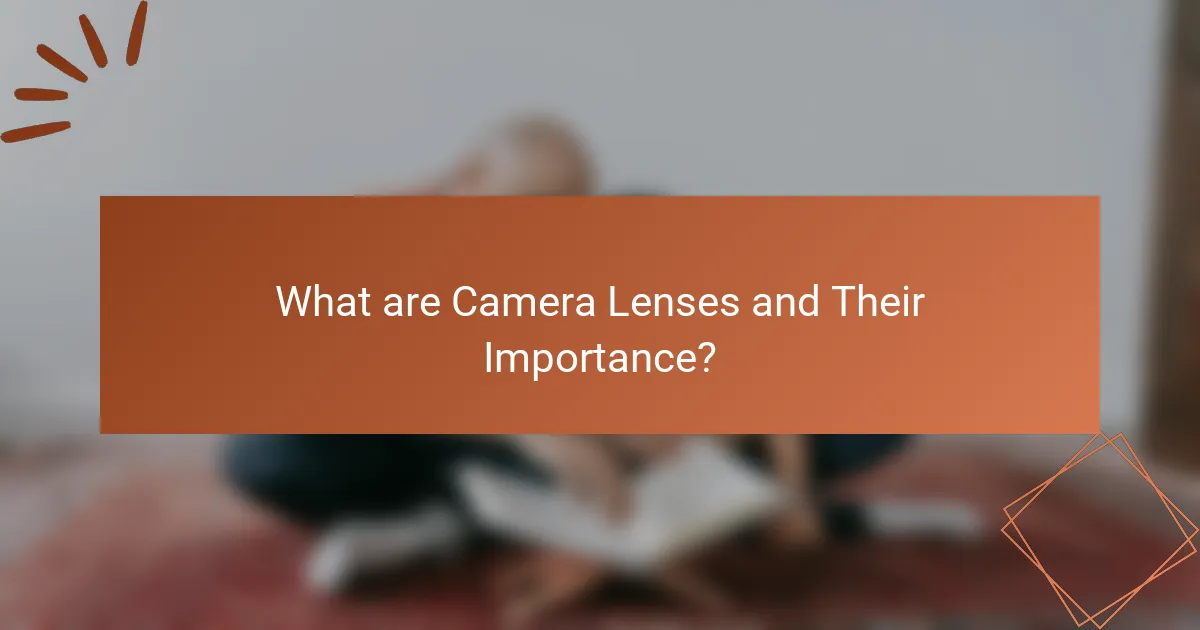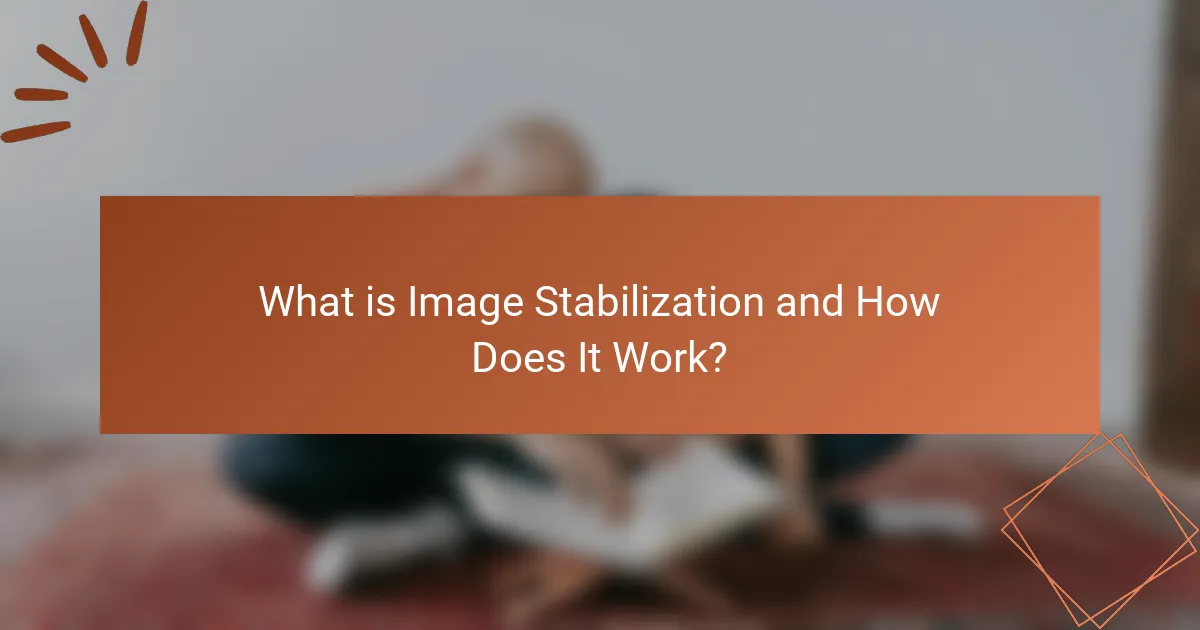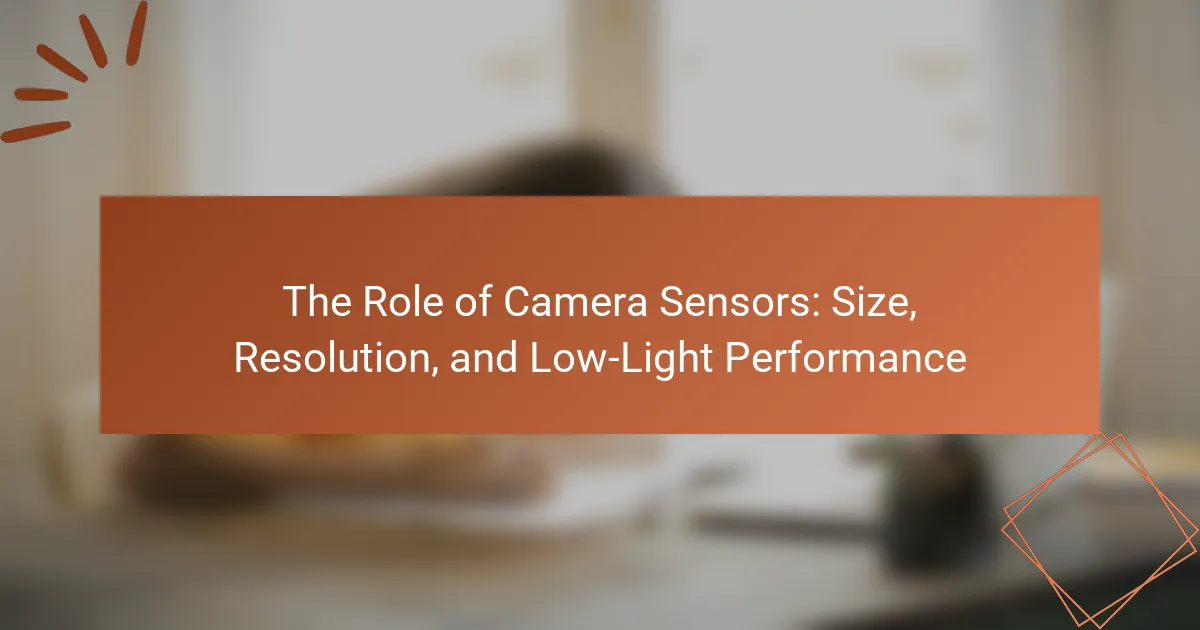Camera lenses are optical devices that focus light onto a camera sensor, playing a critical role in capturing high-quality images and videos. This article explores essential concepts related to camera lenses, including focal length, which determines the field of view and perspective, and aperture, which controls the amount of light entering the camera, influencing exposure and depth of field. Additionally, it discusses image stabilization technologies that mitigate blurriness from camera movement, enhancing clarity in various shooting conditions. Understanding these key elements is vital for photographers seeking to improve their craft and achieve desired artistic effects in their work.

What are Camera Lenses and Their Importance?
Camera lenses are optical devices that focus light onto a camera sensor to create images. They are essential for capturing photographs and videos with clarity and detail. Different lenses have varying focal lengths, which affect the composition and perspective of the image. For instance, a wide-angle lens captures more of the scene, while a telephoto lens magnifies distant subjects. The aperture of a lens controls the amount of light entering the camera, influencing exposure and depth of field. This is crucial for achieving the desired artistic effect in photography. Additionally, image stabilization features in some lenses reduce blurriness caused by camera movement. Overall, camera lenses play a vital role in determining the quality and style of visual media.
How do camera lenses influence photography?
Camera lenses significantly influence photography by determining the image’s perspective, depth of field, and light exposure. The focal length of a lens affects the composition and framing of a photograph. Lenses with shorter focal lengths capture wider scenes, while longer focal lengths allow for closer detail. Aperture settings control the amount of light entering the camera, impacting exposure and depth of field. A wide aperture creates a shallow depth of field, isolating subjects from the background. Conversely, a narrow aperture increases depth of field, keeping more of the scene in focus. Image stabilization features in lenses reduce blur from camera shake, enhancing image clarity. Thus, the choice of lens directly shapes the visual outcome of photographs.
What are the main components of a camera lens?
The main components of a camera lens are the lens elements, aperture, and focusing mechanism. Lens elements are the individual glass pieces that shape and direct light. They are responsible for image clarity and distortion control. The aperture regulates the amount of light entering the lens. It affects exposure and depth of field. The focusing mechanism allows the photographer to adjust the sharpness of the image. This can be manual or automatic. Additional components may include lens coatings for reducing glare and enhancing contrast. These components work together to produce high-quality images.
How do different lenses affect image quality?
Different lenses significantly affect image quality through factors like sharpness, distortion, and color accuracy. The optical design of each lens influences how light is captured. Prime lenses typically offer superior sharpness due to fewer glass elements. Zoom lenses may introduce distortion and reduced sharpness at the extremes of their range. Lens aperture plays a crucial role; wider apertures can create a shallow depth of field, affecting background blur. High-quality lenses often have better coatings, reducing glare and improving contrast. Additionally, lens construction materials impact durability and image quality over time.
What are the primary types of camera lenses?
The primary types of camera lenses include prime lenses, zoom lenses, wide-angle lenses, telephoto lenses, macro lenses, and fisheye lenses. Prime lenses have a fixed focal length, offering sharp images and wider apertures. Zoom lenses provide variable focal lengths, allowing for versatility in framing. Wide-angle lenses capture a broader field of view, ideal for landscapes. Telephoto lenses magnify distant subjects, making them suitable for wildlife photography. Macro lenses enable extreme close-ups, perfect for capturing fine details. Fisheye lenses create a distinctive, spherical perspective, often used for artistic effects. Each lens type serves specific photographic needs, enhancing creativity and technical capabilities in photography.
What distinguishes prime lenses from zoom lenses?
Prime lenses have a fixed focal length, while zoom lenses offer variable focal lengths. This means that prime lenses cannot zoom in or out, requiring the photographer to physically move closer or further away from the subject. In contrast, zoom lenses allow for quick adjustments in composition without changing the lens. Prime lenses typically have larger maximum apertures, enabling better low-light performance and shallower depth of field. This characteristic often results in sharper images due to fewer optical elements. Zoom lenses, however, may introduce more optical distortions and aberrations due to their complex construction. Thus, prime lenses are favored for their image quality and low-light capabilities, while zoom lenses provide versatility in framing and focal range.
How do specialty lenses, like macro and fisheye, differ from standard lenses?
Specialty lenses, such as macro and fisheye, differ from standard lenses primarily in their design and intended use. Macro lenses are specifically designed for extreme close-up photography. They can focus on subjects at a very short distance, often providing a 1:1 magnification ratio. This allows photographers to capture intricate details of small subjects, such as insects or flowers.
Fisheye lenses, on the other hand, are ultra-wide-angle lenses that create a distinct spherical distortion. They typically have a field of view of up to 180 degrees. This distortion allows for creative and dramatic compositions, unlike standard lenses that maintain a more natural perspective.
Standard lenses, often referred to as prime or zoom lenses, are designed for general photography. They typically offer a range of focal lengths and are optimized for everyday shooting conditions. Unlike specialty lenses, they do not excel in extreme close-ups or wide-angle distortion.
The differences are evident in the intended applications of each lens type. Macro lenses are ideal for detail-oriented work, while fisheye lenses are favored for artistic expression. Standard lenses serve as versatile tools for general photography needs.

What is Focal Length and Why Does It Matter?
Focal length is the distance from the lens to the image sensor when the subject is in focus. It is measured in millimeters (mm) and determines the lens’s field of view. A shorter focal length, such as 18mm, captures a wider scene. A longer focal length, like 200mm, zooms in on distant subjects. Focal length affects perspective and depth of field. It influences how images are composed and perceived. Understanding focal length is essential for photographers to achieve desired framing and image quality.
How does focal length affect composition in photography?
Focal length directly influences composition in photography by determining the field of view and perspective. Shorter focal lengths, such as 18mm, capture wider scenes, allowing more elements to fit within the frame. This is ideal for landscapes or group shots. In contrast, longer focal lengths, like 200mm, provide a narrower view, isolating subjects and compressing distance. This is useful for portraits or wildlife photography.
Additionally, focal length affects depth of field. Wide-angle lenses typically have a greater depth of field, keeping more of the scene in focus. Telephoto lenses, however, create a shallower depth of field, which can emphasize the subject while blurring the background.
These characteristics enable photographers to manipulate composition intentionally. For example, a wide-angle lens can exaggerate foreground elements, creating a sense of depth. A telephoto lens can flatten the scene, making subjects appear closer together. Understanding these effects allows photographers to craft more compelling images.
What are the implications of using wide-angle versus telephoto lenses?
Wide-angle lenses capture a broader field of view, while telephoto lenses focus on distant subjects. Wide-angle lenses can create a sense of depth and perspective. They are ideal for landscapes and architecture. Telephoto lenses compress space and isolate subjects effectively. They are often used in wildlife and portrait photography. The choice impacts composition and storytelling in images. Wide-angle lenses may introduce distortion at the edges, while telephoto lenses can create a flattering perspective for portraits. Understanding these implications helps photographers select the appropriate lens for their vision.
How does focal length impact depth of field?
Focal length directly impacts depth of field in photography. A longer focal length results in a shallower depth of field. This means that only a small portion of the image will be in focus. Conversely, a shorter focal length provides a greater depth of field. More elements in the scene will appear sharp. This effect is crucial for achieving specific artistic outcomes. For example, portrait photographers often use longer focal lengths to blur backgrounds. Landscapers typically prefer shorter focal lengths to keep everything in focus. The relationship between focal length and depth of field is a fundamental aspect of lens selection.
What are the practical applications of different focal lengths?
Different focal lengths have distinct practical applications in photography and videography. Short focal lengths, such as 18mm to 35mm, are ideal for wide-angle shots. They capture expansive landscapes and tight interiors effectively. Medium focal lengths, like 50mm to 85mm, are commonly used for portraits. They provide a natural perspective and pleasing background blur. Long focal lengths, starting from 200mm and above, excel in telephoto photography. They allow photographers to capture distant subjects without sacrificing detail.
Each focal length alters the field of view and perspective. Wide-angle lenses exaggerate depth, making foreground subjects appear larger. Telephoto lenses compress space, bringing distant subjects closer together. These differences enable creative expression in various contexts. For instance, sports photographers rely on long focal lengths to capture action from afar. Landscape photographers favor wide angles to encompass vast scenes. The choice of focal length ultimately influences composition and storytelling in visual media.
Which focal lengths are best for portraits versus landscapes?
For portraits, focal lengths between 85mm and 135mm are ideal. These lengths create flattering perspectives and minimize distortion. They allow photographers to maintain a comfortable distance from the subject while achieving good subject isolation.
For landscapes, focal lengths of 16mm to 35mm are preferred. These wider angles capture expansive scenes effectively. They enhance depth and perspective, making landscapes more immersive.
Using these focal lengths aligns with standard photographic practices. Many professional portrait photographers favor 85mm for its flattering compression. Similarly, landscape photographers often choose wide angles to encompass vast vistas.
How do filmmakers use focal length creatively?
Filmmakers use focal length creatively to manipulate perspective and depth in their shots. Different focal lengths can alter how objects appear in relation to one another. For instance, wide-angle lenses (below 35mm) exaggerate distance and create a sense of space. This is often used in establishing shots to showcase vast landscapes. Conversely, telephoto lenses (above 70mm) compress space and bring distant subjects closer. This effect can intensify emotions by isolating characters from their surroundings.
Additionally, filmmakers use focal length to control focus and depth of field. A shallow depth of field, achieved with longer focal lengths, helps isolate subjects and direct audience attention. This technique is prevalent in character-driven narratives. On the other hand, a deep depth of field, common with shorter focal lengths, allows multiple elements in the frame to be in focus. This is useful in storytelling where context is crucial.
Overall, the creative use of focal length enhances visual storytelling by shaping viewer perception and emotional response.

What is Aperture and Its Role in Photography?
Aperture is the opening in a camera lens that controls the amount of light entering the camera. It is measured in f-stops, with lower numbers indicating a wider opening and higher numbers indicating a narrower one. The role of aperture in photography is crucial for exposure, depth of field, and overall image quality. A wider aperture allows more light, enabling better performance in low-light conditions. This can enhance the sharpness of the subject against a blurred background, known as bokeh. Conversely, a smaller aperture increases depth of field, keeping more of the scene in focus. Understanding aperture helps photographers achieve desired artistic effects and manage exposure settings effectively.
How does aperture influence exposure and depth of field?
Aperture controls the amount of light entering the camera and influences depth of field. A wider aperture (lower f-stop number) allows more light, resulting in brighter images. Conversely, a narrower aperture (higher f-stop number) reduces light, leading to darker images.
Depth of field refers to the range of distance in a photo that appears sharp. A wide aperture creates a shallow depth of field, blurring the background and foreground. This effect emphasizes the subject in focus. A narrow aperture increases depth of field, keeping more of the scene in focus.
These relationships are fundamental in photography. For instance, in portrait photography, a wide aperture is often used to isolate the subject. In landscape photography, a narrow aperture is preferred to capture detail throughout the scene.
What are the effects of wide versus narrow apertures on image quality?
Wide apertures allow more light to enter the camera, resulting in brighter images. They also create a shallow depth of field, which isolates subjects by blurring the background. This effect is often desirable in portrait photography. However, wide apertures can lead to lens aberrations, such as softness and vignetting, particularly at the edges of the frame.
Narrow apertures reduce the amount of light entering the camera. This results in darker images but increases depth of field. A greater depth of field keeps more of the scene in focus, which is beneficial for landscape photography. Narrow apertures can also enhance sharpness across the entire image, minimizing lens aberrations.
In summary, wide apertures enhance brightness and subject isolation but may introduce aberrations. Narrow apertures improve depth of field and sharpness but may darken images. The choice of aperture affects overall image quality based on the desired photographic outcome.
How does aperture setting affect motion blur in photography?
Aperture setting directly influences motion blur in photography. A wider aperture (lower f-number) allows more light, enabling faster shutter speeds. Faster shutter speeds reduce motion blur by freezing action. Conversely, a narrower aperture (higher f-number) lets in less light, necessitating slower shutter speeds. Slower shutter speeds increase motion blur as moving subjects are captured over a longer duration. This relationship is critical for photographers aiming to control the appearance of motion in their images.
What are common aperture settings and their uses?
Common aperture settings include f/2.8, f/4, f/5.6, f/8, and f/11. Each setting serves specific purposes in photography.
An aperture of f/2.8 allows more light, ideal for low-light conditions and creating a shallow depth of field. This setting is often used in portrait photography to blur backgrounds.
An aperture of f/4 provides a balance between light and depth of field, suitable for indoor and outdoor photography. It maintains some background detail while still allowing decent light intake.
An aperture of f/5.6 is commonly used for general photography. It offers a good depth of field and is versatile for various lighting conditions.
An aperture of f/8 is often favored for landscape photography. It provides a greater depth of field, keeping more of the scene in focus.
An aperture of f/11 is used for increased depth of field in landscape shots. It ensures sharpness throughout the image, making it suitable for wide scenes.
These settings reflect the relationship between aperture size, light intake, and depth of field in photography.
How do photographers choose the right aperture for different scenarios?
Photographers choose the right aperture based on the desired depth of field and light conditions. A wide aperture (e.g., f/1.8) creates a shallow depth of field, ideal for portraits. This allows the subject to stand out against a blurred background. A narrow aperture (e.g., f/16) increases depth of field, suitable for landscapes. It keeps more of the scene in focus.
Lighting conditions also influence aperture choice. In low light, a wider aperture allows more light to hit the sensor. This helps avoid motion blur and camera shake. Conversely, in bright conditions, a narrower aperture prevents overexposure.
Photographers also consider the lens’s sharpness at different apertures. Most lenses achieve optimal sharpness between f/8 and f/11. This balance maximizes image quality while maintaining the desired depth of field.
By evaluating these factors, photographers effectively select the appropriate aperture for each scenario.
What is the relationship between aperture and ISO settings?
Aperture and ISO settings are both crucial components of exposure in photography. Aperture controls the size of the lens opening, affecting the amount of light that enters the camera. ISO measures the camera sensor’s sensitivity to light. A wider aperture allows more light, which can enable a lower ISO setting to achieve proper exposure. Conversely, a smaller aperture reduces light intake, often necessitating a higher ISO to maintain exposure levels. This relationship allows photographers to balance light and image quality. High ISO can introduce noise, while wide apertures can create shallow depth of field. Understanding this interplay helps achieve desired photographic effects.

What is Image Stabilization and How Does It Work?
Image stabilization is a technology used in cameras and lenses to reduce blurriness caused by camera shake. It works by detecting motion and compensating for it, allowing for clearer images during handheld shooting. There are two main types of image stabilization: optical and digital. Optical stabilization involves physical adjustments to the lens elements or sensor. Digital stabilization uses software to correct motion after the image is captured. This technology is particularly useful in low-light conditions or when using telephoto lenses. Studies show that image stabilization can improve image clarity by up to 4 stops in low-light scenarios, enhancing overall photographic quality.
Why is image stabilization important for photographers?
Image stabilization is important for photographers because it reduces blurriness caused by camera shake. This technology allows for sharper images, especially in low-light conditions or when using slower shutter speeds. Studies show that image stabilization can improve image clarity by up to 4 stops, allowing photographers to shoot at slower shutter speeds without sacrificing image quality. Additionally, it helps in capturing moving subjects more effectively by stabilizing the frame. Overall, image stabilization enhances the overall quality of photographs.
What are the different types of image stabilization systems?
There are three main types of image stabilization systems: optical image stabilization (OIS), electronic image stabilization (EIS), and mechanical image stabilization (MIS). Optical image stabilization involves physical adjustments to the lens elements or image sensor to counteract camera shake. This system is commonly found in lenses for DSLRs and mirrorless cameras. Electronic image stabilization uses software algorithms to analyze and correct motion blur in video footage. This method is often used in smartphones and action cameras. Mechanical image stabilization relies on gimbals or stabilizing rigs to physically stabilize the camera during shooting. Each type of stabilization addresses different filming conditions and user needs.
How does image stabilization affect low-light photography?
Image stabilization significantly enhances low-light photography by reducing the effects of camera shake. This technology allows photographers to capture sharper images at slower shutter speeds. In low-light conditions, longer exposure times are often necessary. Image stabilization compensates for small hand movements during these longer exposures. As a result, images retain clarity without the blurriness that typically occurs in such scenarios. Studies have shown that image stabilization can improve low-light performance by up to four stops. This means photographers can shoot in dim environments without increasing ISO levels excessively, which helps maintain image quality.
What should photographers consider when using image stabilization?
Photographers should consider the type of image stabilization (IS) available in their equipment. There are two main types: optical and electronic stabilization. Optical stabilization works by shifting lens elements to counteract movement. Electronic stabilization uses software to reduce shake in post-processing.
The effectiveness of IS can vary based on the shooting conditions. For example, low light environments benefit significantly from IS. Photographers should also consider the focal length of their lens. Longer focal lengths typically require more stabilization to counteract camera shake.
Additionally, photographers must be aware of the potential for IS to introduce motion blur in fast-moving subjects. Some stabilization systems may not work well during fast panning.
Lastly, understanding the limitations of IS is crucial. It may not eliminate all forms of shake, especially during rapid movements. Knowing when to disable IS, such as on a tripod, can enhance image quality.
How can image stabilization improve handheld shooting experiences?
Image stabilization enhances handheld shooting by reducing blurriness caused by camera shake. It allows for sharper images and smoother video capture. This technology compensates for small movements during shooting. It is particularly beneficial in low-light conditions where longer exposure times are needed. Studies show that image stabilization can improve image clarity by up to 50%. This improvement leads to better overall image quality. Consequently, photographers can achieve professional results without a tripod.
What are common misconceptions about image stabilization?
A common misconception about image stabilization is that it eliminates all camera shake. Image stabilization significantly reduces shake but does not completely remove it. Many believe that image stabilization can compensate for all types of movement, including fast motion or subject movement. However, it primarily addresses small, unintended hand movements. Another misconception is that all image stabilization systems are the same. There are different types, such as optical and digital stabilization, each with varying effectiveness. Some users think that image stabilization is only beneficial for still photography. In reality, it also enhances video stability. Lastly, many believe that image stabilization allows for shooting at any shutter speed without blur. While it helps, using appropriate shutter speeds is still crucial to avoid motion blur.
What are some best practices for using camera lenses effectively?
To use camera lenses effectively, always clean the lens before shooting. Dust and smudges can affect image quality. Use a microfiber cloth and lens cleaner for best results. Adjust the aperture settings according to lighting conditions. A wider aperture allows more light, suitable for low-light environments. Conversely, a smaller aperture increases depth of field, ideal for landscapes.
Utilize the correct focal length for your subject. Wide-angle lenses are perfect for landscapes, while telephoto lenses suit wildlife photography. Always check for lens compatibility with your camera body. Using the right lens ensures optimal performance and image quality.
Experiment with different angles and distances. Changing your perspective can enhance composition. Use a tripod for stability when shooting at slower shutter speeds. This reduces camera shake and results in sharper images. Lastly, practice regularly to understand your lens capabilities and limitations.
How can photographers maintain their lenses for optimal performance?
Photographers can maintain their lenses for optimal performance by regularly cleaning them and storing them properly. Use a microfiber cloth to wipe the lens surface gently. Avoid using harsh chemicals that can damage the lens coating. Keep the lens cap on when not in use to prevent dust and scratches. Store lenses in a dry, cool place to avoid moisture buildup. Use a protective filter to shield the lens from scratches and dirt. Regularly check for fungus or mold and clean if necessary. Proper maintenance can extend the life of the lens and ensure high-quality images.
What tips can enhance creativity with different lenses?
Experimenting with different focal lengths can enhance creativity. Wide-angle lenses can capture expansive scenes, adding depth. Telephoto lenses allow for intimate portraits, isolating subjects. Adjusting aperture settings influences depth of field. A wide aperture creates a blurred background, emphasizing the subject. Conversely, a narrow aperture keeps more elements in focus, enhancing detail. Utilizing image stabilization techniques can improve clarity in dynamic situations. This ensures sharper images, especially in low light. Each lens offers unique attributes that can inspire diverse creative expressions.
Camera lenses are optical devices essential for capturing images with clarity and detail, influencing factors such as perspective, depth of field, and exposure. This article provides an overview of key aspects of camera lenses, including their components, types, and how focal length and aperture settings affect image quality. It also explores the significance of image stabilization in photography, detailing its types and benefits for handheld shooting. By understanding these elements, photographers can enhance their creative capabilities and achieve desired outcomes in their visual media.



